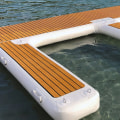Welcome to our comprehensive guide on foam-filled floats for floating dock design! If you're looking to build a floating dock near West Ashley SC, then you've come to the right place. Whether you're a seasoned dock builder or a first-time DIYer, understanding the ins and outs of foam-filled floats is crucial for creating a sturdy and reliable floating dock near West Ashley SC. In this article, we'll dive into the world of foam-filled floats, discussing their benefits, uses, and how they can enhance your overall floating dock design near West Ashley SC. So, let's get started and explore the world of foam-filled floats together!Foam-filled floats are an essential component when it comes to building a floating dock near West Ashley SC.
Not only do they provide buoyancy and support for the dock, but they also play a crucial role in its overall stability and longevity. These large blocks or cylinders made of high-density foam are specifically designed to support the weight of a floating dock. They come in various shapes and sizes, depending on the specific needs of the dock. When constructing a floating dock, there are a few key factors to consider when it comes to foam-filled floats. One important factor is the type of foam used.
High-density foam is typically preferred for its strength and durability. It is also important to ensure that the foam is properly sealed and protected from water and UV rays to prevent deterioration over time. The size of the foam-filled floats is another crucial aspect to consider. The size will depend on the weight and size of the dock, as well as the intended use. A larger dock with heavy equipment or frequent foot traffic will require larger and more buoyant floats for proper support. The overall design of the floating dock also plays a role in the selection of foam-filled floats.
The placement and arrangement of the floats can affect the stability and functionality of the dock. It is important to consult with a professional or follow industry guidelines to ensure that the floats are properly placed and secured for optimal performance. In conclusion, foam-filled floats are an integral part of floating dock design. They provide essential buoyancy and support, while also contributing to the stability and longevity of the dock. When considering foam-filled floats, it is important to pay attention to the type of foam used, the size of the floats, and the overall design of the dock.
By carefully considering these factors, you can ensure a successful and durable floating dock project.
Encapsulated Floats
Encapsulated floats are made of a durable polyethylene shell and filled with foam. They are more expensive than EPS floats, but they offer superior strength and longevity. Encapsulated floats are also resistant to UV rays, chemicals, and punctures, making them a popular choice for harsh marine environments.EPS Floats
When it comes to foam-filled floats for floating dock design, one popular choice is EPS, which stands for Expanded Polystyrene. This material has become a top choice for many due to its lightweight and durable properties. One of the main benefits of using EPS floats is its excellent buoyancy.This means that it can easily support the weight of a floating dock while providing stability and preventing it from sinking. Additionally, EPS floats are also more affordable compared to encapsulated floats, making it a cost-effective option for those on a budget.
Sizing and Design Considerations
When it comes to sizing, the general rule of thumb is to use one cubic foot of foam for every 50 pounds of weight that the float will support. However, this can vary depending on the design and layout of the dock. It's essential to consult with a professional or use online calculators to determine the appropriate float size for your specific project. Additionally, the design of the dock should also consider factors such as wave action, wind load, and water depth to ensure maximum stability and safety.Types of Foam-Filled Floats
When it comes to foam-filled floats for floating dock design, there are two main types that are commonly used: EPS and encapsulated floats.Each type has its own unique characteristics and benefits, so it's important to understand the differences between them before deciding on which one to use for your project.
EPS Floats
EPS (expanded polystyrene) floats are made from a lightweight, closed-cell foam material that is known for its excellent buoyancy and strength. This type of float is typically used for smaller docks or in areas with calm water conditions. The main advantage of EPS floats is their cost-effectiveness and ease of installation. They are also resistant to chemicals, UV rays, and marine life, making them a durable option for long-term use.Encapsulated Floats
Encapsulated floats, also known as rotationally-molded floats, are made from a high-density polyethylene (HDPE) shell that is filled with foam.This type of float is known for its superior strength and durability, making it ideal for larger docks or in areas with rough water conditions. The HDPE shell also provides protection against punctures, UV rays, and marine life, making it a more long-lasting option compared to EPS floats. When choosing between EPS and encapsulated floats, it's important to consider the size and location of your floating dock, as well as your budget and long-term maintenance needs. Both types of foam-filled floats offer excellent buoyancy and support for your dock, so it ultimately comes down to which one best fits your specific project needs. In conclusion, foam-filled floats are an integral part of floating dock construction. They provide buoyancy, support, and stability, making them a crucial component for any dock project.
When choosing foam-filled floats, consider factors such as type, size, and design to ensure the best results. With proper installation and maintenance, foam-filled floats can last for many years and offer a cost-effective solution for floating docks.






